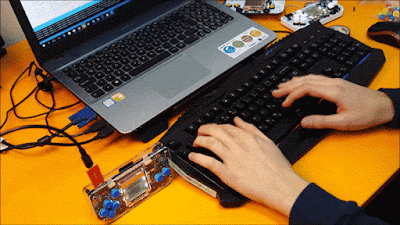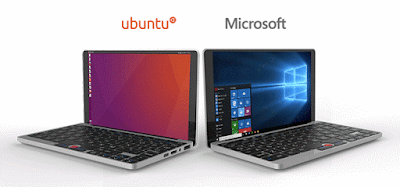What's up, everyone? SHARD Labs is back after a slight hiatus to bring our latest (former) Kickstarter review... the Hexiwear development system by MikroElektronika. They were gracious enough to send out a review just after the holidays. You can find them (and preorder a Hexiwear for yourself) at the link below:
So without further ado, let's get into the review!
What is Hexiwear? The box our review unit came in, on the side, describes it as "A wearable development kit for the IoT (Internet of Things) era. A small and sleek, low-powered device packed with sensors to quantify yourself and the world around you."
That describes the device pretty well. Essentially, it's a small handheld puck-like device, made of high-quality plastic and glass, with a small screen and buttons. It can be used as a smartwatch, a smart sensor, or a smart... anything, really. It all depends on what you program it to be.
The Hexiwear development kit comes in a snazzy red-and white box with colorful, minimalistic designs patterned on the outside. Our kit was the "Power User Pack," so it came with two separate sections inside the box; the Hexiwear and accessories, and the docking station. Here's a comprehensive list of everything inside:
-1x Hexiwear (with glass front panel)
-2x Extra front panels (in different colors)
-1x MicroUSB cable
-1x Smartwatch strap
-1x Keychain case
-1x Docking station
There's a lot of fun stuff inside. I'll cover it all in more detail in the upcoming sections.
The Hexiwear is a pretty powerful little device. Unlike development boards developed upon the Arduino system, the Hexiwear is based on a microcontroller operating system, meaning multiple apps can be loaded and run on it at the same time. It features a color OLED screen and six capacitative buttons on the outside of the screen that control it. It also comes chock-full of sensors.
Processor: An NXP Kinetis K64 MCU (Running an ARM Cortex-M4, 120MHz processor with 1M Flash and 256K SRAM)
Connectivity: NXP Kinetis KW4x Bluetooth Low Energy & 802.15.4 Wireless MCU
Battery: 190 mAh 2C Li-Po battery
Sensors:
-Accelerometer and Magnetometer
-3-Axis Gyroscope
-Absolute Digital Pressure sensor
-Light-to-digital converter
-Digital humidity and temperature sensor
-Heart-rate sensor
Output:
-1.1" full color OLED display
-Haptic feedback engine
-RGB LED
...That's a lot of specs. And that's just in the Hexiwear itself! If you connect it to the docking station, the expansion slots allow for hundreds of additional sensors, outputs, and configuration. It's somewhat mind-boggling.
Besides expansion (or, as they call them, "click boards,") the docking station also allows you to enhance the core functionality with an onboard programmer, a microSD slot, and a I2S interface. This allows you to design your own circuits and connect them to the Hexiwear.
What else comes in the box? Why, accessories, of course. There are several fun ways to pimp out your Hexiwear and increase its functionality included in the kit. There are two types of rubber cases- one has straps, for smartwatch functionality, and the other includes a keychain hole (or you can use the hole to attach it to anything else.)
I'm currently using the keychain case for mine right now, and it works very well for keeping the Hexiwear safe and carrying it around.
The other interesting feature is the faceplates. The Hexiwear power user pack comes with three different-colored faceplates: yellow, green and blue. This allows you to personalize your Hexiwear to whichever color you like best. And the capacitative buttons on the faceplate work quite well, and are very responsive.
Hexiwear runs on a custom OS designed for the low-power MCU inside. The GUI is very clean and minimalistic, and comes with several apps preloaded. They are:
-Weather
-Motion
-Flashlight
-Fitness
Fitness is actually two apps, Pedometer and Heart rate. Weather measures the air around you and gives you a real-time list of temperature, humidity, and pressure. Motion measures acceleration and rotation along the X, Y, and Z-axis. Flashlight turns on the RGB LED to full white, and fitness does two tasks. Pedometer does just what it says, measuring your step count (while the app is open) Heart rate uses an optical heart-rate sensor on the underside of the device. when you put a finger or wrist up to the sensor, it begins tracking your heart's BPM (beats per minute) in real-time. I found the heart-rate sensor to be a little of balance, as it jumped around quite a bit as it measured my pulse.
The battery lasts a remarkably long time for its small size, thanks to the low-power MCU. The software has a power-saver feature built in, so that whenever the Hexiear isn't in use, it shuts off its screen after several seconds. It can be woken up by double-tappling one of the buttons or by shaking the device.
There's not much to see software-wise with the Hexiwear, out of the box. That's because Hexiwear is first and foremost a development program. The real programs are the one you and all the users design for it.
So how do you program the the Hexiwear? Well, there are two ways of interfacing with the device. For just reading the measurements off the Hexiwear, you can download an app on either the Google Play or iOS app store and connect to the device via bluetooth. This allows you to get real-time stats and update your Hexiwear via OTAP (Over the air programming.) The iOS version of the app (which this was tested on) worked smoothly and without any hiccups, quickly pairing via bluetooth and syncing the readings in real-time.
Each Hexiwear user also gets access to a private cloud where all the sensor readings are stored, provided by WolkAbout. WolkAbout is an Internet of Things company and partner of MikroElektronika.
For actual app creation, the Kinetis Design Studio (KDS) is a free integrated development enviroment the MCU. Based on open-source software, such as Eclipse, GCC, GDB, and others, the KDS IDE is a simple development tool for designers.
The Hexiwear is also ARM mbed OS 5, as well as mikroC compatible, meaning you can write programs for the Hexiwear in whatever programming language you love best!
There's so much to do with Hexiwear, and SHARD Labs will continue to explore and work on developing for the Hexiwear over time. Did we convince you to buy one? If so, head over to
the Shop and order your own. Plus, leave a comment saying that you did so! (And what you thought of the review.)
Until next time,
..Carter..


























